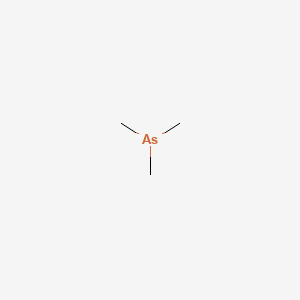Trimethylarsine
- Trimethylarsine
- trimethylarsane
- 593-88-4
- Trimethylarsenic
- Arsine, trimethyl-
- Create:2005-03-27
- Modify:2025-01-11

- Trimethylarsine
- trimethylarsane
- 593-88-4
- Trimethylarsenic
- Arsine, trimethyl-
- AsMe3
- (CH3)3As
- UNII-MQ83UQ8A1Q
- EINECS 209-815-8
- MQ83UQ8A1Q
- BRN 1730780
- DTXSID4073203
- CHEBI:27130
- 4-04-00-03665 (Beilstein Handbook Reference)
- MFCD00014838
- Arsine, trimethyl
- Trimethylarsine, elec. gr.
- trimethylarsane;trimethylarsenic
- DTXCID1042603
- HTDIUWINAKAPER-UHFFFAOYSA-N
- DB-009876
- NS00079984
- C22417
- Q421500




H225 (40.9%): Highly Flammable liquid and vapor [Danger Flammable liquids]
H260 (59.1%): In contact with water releases flammable gases which may ignite spontaneously [Danger Substances and mixtures which in contact with water, emit flammable gases]
H261 (40.9%): In contact with water releases flammable gas [Danger Substances and mixtures which in contact with water, emit flammable gases]
H300 (59.1%): Fatal if swallowed [Danger Acute toxicity, oral]
H301 (40.9%): Toxic if swallowed [Danger Acute toxicity, oral]
H315 (59.1%): Causes skin irritation [Warning Skin corrosion/irritation]
H319 (59.1%): Causes serious eye irritation [Warning Serious eye damage/eye irritation]
H331 (100%): Toxic if inhaled [Danger Acute toxicity, inhalation]
H335 (59.1%): May cause respiratory irritation [Warning Specific target organ toxicity, single exposure; Respiratory tract irritation]
H400 (100%): Very toxic to aquatic life [Warning Hazardous to the aquatic environment, acute hazard]
H410 (100%): Very toxic to aquatic life with long lasting effects [Warning Hazardous to the aquatic environment, long-term hazard]
P210, P223, P231+P232, P233, P240, P241, P242, P243, P261, P264, P264+P265, P270, P271, P273, P280, P301+P316, P302+P335+P334, P302+P352, P303+P361+P353, P304+P340, P305+P351+P338, P316, P319, P321, P330, P332+P317, P337+P317, P362+P364, P370+P378, P391, P402+P404, P403+P233, P403+P235, P405, and P501
(The corresponding statement to each P-code can be found at the GHS Classification page.)
Aggregated GHS information provided per 93 reports by companies from 2 notifications to the ECHA C&L Inventory. Each notification may be associated with multiple companies.
Information may vary between notifications depending on impurities, additives, and other factors. The percentage value in parenthesis indicates the notified classification ratio from companies that provide hazard codes. Only hazard codes with percentage values above 10% are shown.
Flam. Liq. 2 (40.9%)
Water-react. 1 (59.1%)
Water-react. 2 (40.9%)
Acute Tox. 2 (59.1%)
Acute Tox. 3 (40.9%)
Skin Irrit. 2 (59.1%)
Eye Irrit. 2 (59.1%)
Acute Tox. 3 (100%)
STOT SE 3 (59.1%)
Aquatic Acute 1 (100%)
Aquatic Chronic 1 (100%)
Patents are available for this chemical structure:
https://patentscope.wipo.int/search/en/result.jsf?inchikey=HTDIUWINAKAPER-UHFFFAOYSA-N
- CAS Common ChemistryLICENSEThe data from CAS Common Chemistry is provided under a CC-BY-NC 4.0 license, unless otherwise stated.https://creativecommons.org/licenses/by-nc/4.0/Trimethylarsinehttps://commonchemistry.cas.org/detail?cas_rn=593-88-4
- ChemIDplusChemIDplus Chemical Information Classificationhttps://pubchem.ncbi.nlm.nih.gov/source/ChemIDplus
- EPA Chemicals under the TSCAArsine, trimethyl-https://www.epa.gov/chemicals-under-tscaEPA TSCA Classificationhttps://www.epa.gov/tsca-inventory
- EPA DSSToxArsine, trimethyl-https://comptox.epa.gov/dashboard/DTXSID4073203CompTox Chemicals Dashboard Chemical Listshttps://comptox.epa.gov/dashboard/chemical-lists/
- European Chemicals Agency (ECHA)LICENSEUse of the information, documents and data from the ECHA website is subject to the terms and conditions of this Legal Notice, and subject to other binding limitations provided for under applicable law, the information, documents and data made available on the ECHA website may be reproduced, distributed and/or used, totally or in part, for non-commercial purposes provided that ECHA is acknowledged as the source: "Source: European Chemicals Agency, http://echa.europa.eu/". Such acknowledgement must be included in each copy of the material. ECHA permits and encourages organisations and individuals to create links to the ECHA website under the following cumulative conditions: Links can only be made to webpages that provide a link to the Legal Notice page.https://echa.europa.eu/web/guest/legal-noticeTrimethylarsine (EC: 209-815-8)https://echa.europa.eu/information-on-chemicals/cl-inventory-database/-/discli/details/5902
- FDA Global Substance Registration System (GSRS)LICENSEUnless otherwise noted, the contents of the FDA website (www.fda.gov), both text and graphics, are not copyrighted. They are in the public domain and may be republished, reprinted and otherwise used freely by anyone without the need to obtain permission from FDA. Credit to the U.S. Food and Drug Administration as the source is appreciated but not required.https://www.fda.gov/about-fda/about-website/website-policies#linking
- ChEBITrimethylarsinehttps://www.ebi.ac.uk/chebi/searchId.do?chebiId=CHEBI:27130
- Toxin and Toxin Target Database (T3DB)LICENSET3DB is offered to the public as a freely available resource. Use and re-distribution of the data, in whole or in part, for commercial purposes requires explicit permission of the authors and explicit acknowledgment of the source material (T3DB) and the original publication.http://www.t3db.ca/downloadsTrimethylarsinehttp://www.t3db.ca/toxins/T3D0305
- Comparative Toxicogenomics Database (CTD)LICENSEIt is to be used only for research and educational purposes. Any reproduction or use for commercial purpose is prohibited without the prior express written permission of NC State University.http://ctdbase.org/about/legal.jsptrimethylarsinehttps://ctdbase.org/detail.go?type=chem&acc=C009572
- Crystallography Open Database (COD)LICENSEAll data in the COD and the database itself are dedicated to the public domain and licensed under the CC0 License. Users of the data should acknowledge the original authors of the structural data.https://creativecommons.org/publicdomain/zero/1.0/
- Haz-Map, Information on Hazardous Chemicals and Occupational DiseasesLICENSECopyright (c) 2022 Haz-Map(R). All rights reserved. Unless otherwise indicated, all materials from Haz-Map are copyrighted by Haz-Map(R). No part of these materials, either text or image may be used for any purpose other than for personal use. Therefore, reproduction, modification, storage in a retrieval system or retransmission, in any form or by any means, electronic, mechanical or otherwise, for reasons other than personal use, is strictly prohibited without prior written permission.https://haz-map.com/AboutTrimethylarsinehttps://haz-map.com/Agents/18359
- Japan Chemical Substance Dictionary (Nikkaji)
- KEGGLICENSEAcademic users may freely use the KEGG website. Non-academic use of KEGG generally requires a commercial licensehttps://www.kegg.jp/kegg/legal.html
- Metabolomics Workbench
- NORMAN Suspect List ExchangeLICENSEData: CC-BY 4.0; Code (hosted by ECI, LCSB): Artistic-2.0https://creativecommons.org/licenses/by/4.0/TrimethylarsineNORMAN Suspect List Exchange Classificationhttps://www.norman-network.com/nds/SLE/
- Rhea - Annotated Reactions DatabaseLICENSERhea has chosen to apply the Creative Commons Attribution License (http://creativecommons.org/licenses/by/4.0/). This means that you are free to copy, distribute, display and make commercial use of the database in all legislations, provided you credit (cite) Rhea.https://www.rhea-db.org/help/license-disclaimer
- SpectraBaseArsine, trimethyl-https://spectrabase.com/spectrum/JD06gi9NnAIArsine, trimethyl-https://spectrabase.com/spectrum/LSiniz0nASn
- Springer Nature
- Thieme ChemistryLICENSEThe Thieme Chemistry contribution within PubChem is provided under a CC-BY-NC-ND 4.0 license, unless otherwise stated.https://creativecommons.org/licenses/by-nc-nd/4.0/
- Wikidatatrimethylarsinehttps://www.wikidata.org/wiki/Q421500
- WikipediaMethyl isopropyl ketonehttps://en.wikipedia.org/wiki/Methyl_isopropyl_ketoneTrimethylarsinehttps://en.wikipedia.org/wiki/Trimethylarsine
- Wiley
- PubChem
- Medical Subject Headings (MeSH)LICENSEWorks produced by the U.S. government are not subject to copyright protection in the United States. Any such works found on National Library of Medicine (NLM) Web sites may be freely used or reproduced without permission in the U.S.https://www.nlm.nih.gov/copyright.htmltrimethylarsinehttps://www.ncbi.nlm.nih.gov/mesh/67009572
- GHS Classification (UNECE)GHS Classification Treehttp://www.unece.org/trans/danger/publi/ghs/ghs_welcome_e.html
- EPA Substance Registry ServicesEPA SRS List Classificationhttps://sor.epa.gov/sor_internet/registry/substreg/LandingPage.do
- MolGenieMolGenie Organic Chemistry Ontologyhttps://github.com/MolGenie/ontology/
- PATENTSCOPE (WIPO)SID 403461031https://pubchem.ncbi.nlm.nih.gov/substance/403461031
